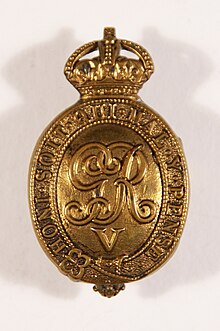
The Governor General's Horse Guards is an armoured cavalry regiment in the Primary Reserve of the Canadian Army. The regiment is part of 4th Canadian Division's 32 Canadian Brigade Group and is based in Toronto, Ontario. It is the most senior reserve regiment in Canada, and the only household cavalry regiment of Canada's three household units.
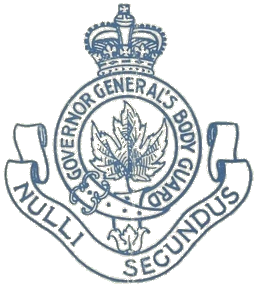
The Governor General's Body Guard was a royal guard regiment of the Canadian Army that formed part of the country's household troops. The Body Guard was the senior regiment of the Canadian Army and the equivalent of the British Army's Life Guards and Royal Horse Guards. In 1936 the regiment amalgamated with the Mississauga Horse to become The Governor General's Horse Guards.

The Welch Regiment was an infantry regiment of the line of the British Army in existence from 1881 until 1969. The regiment was created in 1881 under the Childers Reforms by the amalgamation of the 41st (Welch) Regiment of Foot and 69th Regiment of Foot to form the Welsh Regiment, by which it was known until 1920 when it was renamed the Welch Regiment. In 1969 the regiment was amalgamated with the South Wales Borderers to form the Royal Regiment of Wales.

The Royal Newfoundland Regiment is a Primary Reserve infantry regiment of the Canadian Army. It is part of the 5th Canadian Division's 37 Canadian Brigade Group.
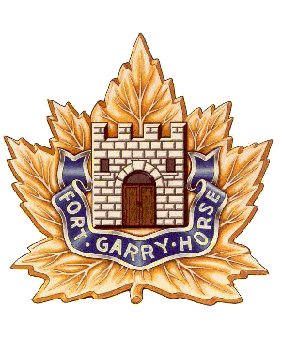
The Fort Garry Horse is a Canadian Army Reserve armoured regiment based in Winnipeg, Manitoba, Canada. It is part of 3rd Canadian Division's 38 Canadian Brigade Group. It traces its history to a cavalry regiment first formed in 1912 that first took up the name "Fort Garry" a year afterwards. Since that time the regiment has served in the First World War, sending men to battalions of the Canadian Expeditionary Force, and as an armoured regiment in the Second World War.
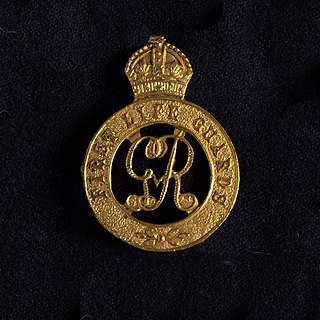
The 1st Regiment of Life Guards was a cavalry regiment in the British Army, part of the Household Cavalry. It was formed in 1788 by the union of the 1st Troop of Horse Guards and 1st Troop of Horse Grenadier Guards. In 1922, it was amalgamated with the 2nd Life Guards to form the Life Guards.

The Royal Guernsey Light Infantry was an infantry regiment of the British Army that was formed from the Royal Guernsey Militia in 1916 to serve in World War I. They fought as part of the British 29th Division. Of the 2,280 men, most of whom came from Guernsey, who fought on the Western Front with the RGLI, 327 were killed and 667 were wounded.
The 5th Battalion was an infantry battalion of the Australian Army. Raised in Victoria as part of the First Australian Imperial Force for service during World War I, the battalion formed part of the 2nd Brigade, attached to the 1st Division. It participated in the landing at Anzac Cove on 25 April 1915, coming ashore in the second wave, before taking part in the fighting at Krithia and then at Lone Pine. In December 1915, the battalion was withdrawn from the peninsula and returned to Egypt where it was involved in defending the Suez Canal until being transferred to the Western Front in France in early 1916. After that, over the course of the next two and a half years the 5th Battalion was rotated in and out of the front line and took part in a number of significant battles including at Pozieres, Ypres, Amiens and the Hindenburg Line. Following the end of the war, the battalion was disbanded and its personnel returned to Australia. The battalion was re-raised during the inter-war years as a part-time unit and was later mobilised during World War II, but did not serve overseas. During the post war period, the battalion has existed at various times before being subsumed into the 5th/6th Battalion, Royal Victoria Regiment.
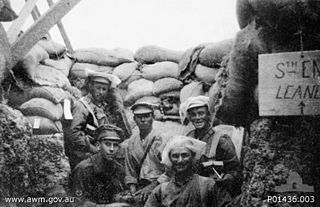
The 12th Battalion was an infantry battalion originally raised for the First Australian Imperial Force during the First World War. The battalion was recruited from Tasmania, South Australia and Western Australia and formed part of the 3rd Brigade, 1st Division. It served throughout the war, firstly during the Gallipoli Campaign and then on the Western Front. During the interwar years, the 12th Battalion was re-raised as a part-time military unit and during the Second World War undertook garrison duties in Australia, but did not see combat. Today its lineage is perpetuated by the 12th/40th Battalion, Royal Tasmania Regiment, a unit which continues to serve in the Australian Army Reserve.

The 2nd Regiment of Life Guards was a cavalry regiment in the British Army, part of the Household Cavalry. It was formed in 1788 by the union of the 2nd Troop of Horse Guards and 2nd Troop of Horse Grenadier Guards. In 1922, it was amalgamated with the 1st Life Guards to form The Life Guards.
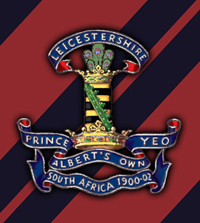
The Leicestershire Yeomanry (Prince Albert's Own) was a yeomanry regiment of the British Army, first raised in 1794 and again in 1803, which provided cavalry and mounted infantry in the Second Boer War and the First World War and provided two field artillery regiments of the Royal Artillery in the Second World War, before being amalgamated with the Derbyshire Yeomanry to form the Leicestershire and Derbyshire (Prince Albert's Own) Yeomanry in 1957. The regiment's lineage is currently perpetuated by E (Leicestershire and Derbyshire Yeomanry) Squadron of the Royal Yeomanry.

The Worcestershire Regiment was a line infantry regiment in the British Army, formed in 1881 under the Childers Reforms by the amalgamation of the 29th (Worcestershire) Regiment of Foot and the 36th (Herefordshire) Regiment of Foot. The regiment fought in many conflicts, including both the First and Second World Wars, until 1970, when it was amalgamated with the Sherwood Foresters to form the Worcestershire and Sherwood Foresters Regiment. In September 2007, the regiment amalgamated with the Cheshire Regiment and the Staffordshire Regiment to form the Mercian Regiment.
The Household Cavalry Composite Regiment was a temporary, wartime-only, cavalry regiment of the British Army consisting of personnel drawn from the 1st Life Guards, 2nd Life Guards and Royal Horse Guards. It was active in 1882 for service in the Anglo-Egyptian War, in 1889–1900 during the Second Boer War, from August to November, 1914 during the opening months of World War I and in World War II.
The 4th Cavalry Brigade was a cavalry brigade of the British Army. It served in the Napoleonic Wars, in the First World War on the Western Front where it was initially assigned to The Cavalry Division before spending most of the war with the 2nd Cavalry Division, and with the 1st Cavalry Division during the Second World War.

The Guards Division was an infantry division of the British Army that was formed in the Great War in France in 1915 from battalions of the Guards regiments from the Regular Army. The division served on the Western Front for the duration of the First World War. The division's insignia was the "All Seeing Eye".

The following battle honours were awarded to units of the British Army and the armies of British India and the Dominions of the British Empire. From their institution until the end of the Second World War, awards were made by, or in consultation with, the British government, but, since 1945, the individual countries of the former British Empire have awarded battle honours to their forces independently.

The 4th Light Horse Regiment was a mounted infantry regiment of the Australian Army during the First World War. The regiment was raised in August 1914, as the divisional cavalry regiment for the 1st Division. The regiment fought against the forces of the German Empire and the Ottoman Empire, in Egypt, at Gallipoli, on the Western front, on the Sinai Peninsula, and in Palestine and Jordan. After the armistice the regiment eventually returned to Australia in March 1919. For its role in the war the regiment was awarded twenty-one battle honours.
The 7th Cavalry Brigade was a cavalry brigade of the British Army. It served in the Napoleonic Wars, notably at the Battle of Waterloo. It was reformed in 1914 and served on the Western Front as part of the 3rd Cavalry Division until the end of World War I.

The 38th Battalion was an infantry battalion of the Australian Army. Originally formed in 1916 for service overseas during World War I as part of the Australian Imperial Force (AIF), the battalion was recruited from the state of Victoria and formed part of the 10th Brigade, 3rd Division. It served throughout the war on the Western Front before being disbanded in 1919. During the inter-war years, the battalion was re-raised as a part-time military unit and during the World War II undertook garrison duties in Australia, but did not see combat. After the war, it was re-formed in Victoria and was eventually subsumed into the Royal Victoria Regiment, with its honours and traditions being preserved by the 8th/7th Battalion, Royal Victoria Regiment.
The Warwickshire Royal Horse Artillery was a Territorial Force Royal Horse Artillery battery that was formed in Warwickshire in 1908. It was the first Territorial Force artillery unit to go overseas on active service, spending the whole of the First World War on the Western Front, mostly with 1st Cavalry Division and 29th Division. A second line battery, 2/1st Warwickshire RHA, also served on the Western Front in 1917 and 1918 as part of an Army Field Artillery Brigade. Post-war it was reconstituted as a Royal Field Artillery battery.
